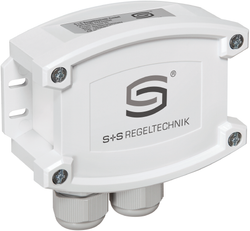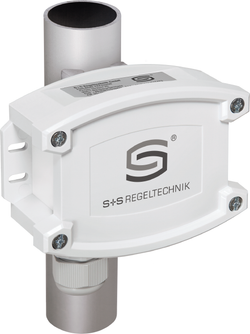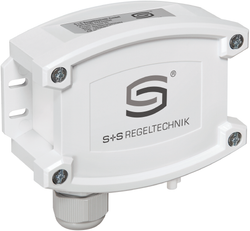- Home
- Modbus | Wireless Modbus
- W-Modbus sensors
W-Modbus sensors
Industrial communication and automation systems are increasingly relying on wireless networks to increase efficiency and flexibility. One of the best-known and most frequently used communication methods in this context is Modbus - an open communication protocol that is often used in industry for networking devices. Wireless Modbus (W-Modbus) is the wireless version of the classic Modbus protocol, which relies on radio technologies to utilize the advantages of wireless data transmission.

-
HYGRASGARD® RFTF-wModbus
1201-41BF-1000-000
- 0...100 % RH (humidity)
0...+50 °C (temperature) - Temperature [°C] [°F], relative humidity [% RH],
dew point [°C] [°F], absolute humidity [g/m³] [gr/ft³],
mixing ratio [g/kg] [gr/lb], enthalpy [kJ /kg] [Btu/lb] - SI (default) or Imperial (switchable via Modbus)
- W-Modbus
- IP 30 (according to EN 60 529)
$264.42
$314.58
- 0...100 % RH (humidity)
What is W-Modbus?
W-Modbus uses the same communication principles as Modbus RTU or Modbus TCP, but the connection is not established via cable, but wirelessly, e.g. via WLAN, Zigbee or LoRaWAN. This allows systems to be installed more flexibly and cost-effectively, especially in systems that are difficult to access or widely distributed.
What is it used for?
Modbus wireless offers numerous advantages over conventional, wired communication solutions. It enables flexible and cost-effective networking of devices and systems in areas where cable connections would be either impractical or too expensive.
Why Wireless Modbus?
The main advantages of Wireless Modbus are:
- Signal transmission with low latencyalmost instantaneous data transmission, which is particularly important in applications with real-time requirements.
- Cost and time savings: Saving on cables and installation costs reduces the overall investment costs. Troubleshooting can be carried out remotely.
- Simple expandabilityWireless systems can be expanded without great effort, which is particularly advantageous for growing systems or distributed systems.
- Flexibility and high rangeThanks to the lack of cables, devices can also be integrated in areas that are difficult to access or far away, where cable installations are not technically or economically possible.
- Fast commissioningWireless Modbus systems can be set up more quickly, resulting in faster commissioning and less downtime.
Scope of application of W-Modbus
The possible uses of Wireless Modbus devices are extremely versatile and are used in numerous industries. W-Modbus is often used in environments where fast and flexible communication is required and cabling is either too complex or impractical. Wireless technology is particularly interesting for retrofitting in existing buildings (retrofit).
Areas of application of W-Modbus
-
Manufacturing industry and automation
In modern production facilities and manufacturing plants Wireless Modbus wireless communication between machines, sensors and control systems without the need for a complex cable network. This is particularly advantageous in systems with moving parts or when retrofitting existing systems.
Energy management and smart grids
In the energy sector, especially in smart grids and intelligent power networks, wireless Modbus technology is used to collect and transmit data from widely distributed energy sources (such as wind turbines, solar farms or electricity meters). Wireless communication enables the integration of remote or hard-to-reach stations without the need for complex cable connections.
-
Building automation and smart buildings
In the area of building automation W-Modbus-systems are used to network and control various building technologies such as lighting, heating, ventilation and air conditioning (HVAC). Wireless Modbus systems are particularly useful here to facilitate installation and maintenance.
Agricultural engineering and environmental monitoring
In agriculture or for environmental monitoring W-Modbus-systems can be used for remote monitoring of weather stations, irrigation systems or climate sensors. In remote areas where the installation of cables would be difficult, wireless communication offers a reliable solution for transmitting measurement data.
Logistics and transportation
In the logistics industry, Modbus enables the monitoring of warehouse stocks, vehicle fleets or automated warehouse systems without cables. Wireless communication provides an efficient and flexible solution for the remote control and monitoring of logistics systems.
What to look out for when buying
When buying a Wireless Modbus-There are several factors to consider when selecting a device to ensure that it meets the specific requirements of the application:
Radio technologyCheck which wireless standards can be used in your area.
Range and signal strength: Pay attention to the maximum range and the stability of the connection, especially in complex or large installations.
CompatibilityEnsure that the device is compatible with your existing Modbus infrastructure and the other systems used.
Security functionsCheck whether the device has security functions such as encryption and authentication to protect data from unauthorized access.
Energy consumptionEnergy consumption is crucial for appliances that are used in remote areas without an external power supply. Look out for energy-efficient models.

FAQ
- What is the difference between Modbus RTU and W-Modbus?
Modbus RTU is a wired version of the Modbus protocol that uses a serial connection. Wireless Modbus however, transmits the same data wirelessly, allowing for a more flexible and often more cost-effective installation.
- Can Wireless Modbus be used in any network?
Not every wireless network is suitable for communicating with W-Modbus suitable. It is important that the network used offers the required range, stability and security.
- How secure is data transmission with Wireless Modbus?
The safety of Wireless Modbus depends on the wireless technology used and the security protocols employed. Encryption and authentication are crucial to protect data from unauthorized access.
- What is the range of a typical Wireless Modbus-device?
The range varies depending on the radio technology used. As a rule, the range of a W-Modbus-The maximum range of the device is between 30 and 100 meters in open areas (up to 500 m in open areas), but can be affected by obstacles and interference.
How do I integrate W-Modbus
The integration of Wireless Modbus into existing systems is relatively straightforward and requires only a few steps:
- PreparationDetermine the required devices, wireless technologies and network architecture.
- Installation: Connect the W-Modbus-compatible devices with your existing Modbus network or controller.
- ConfigurationSet up the wireless connection and configure IP addresses and communication parameters.
- TestingCheck the stability and range of the wireless connection and the communication between the devices.
- MaintenanceRegular signal strength checks, security measures and software updates ensure that the system works reliably.

 All W-Modbus Discover sensors
All W-Modbus Discover sensorsIn the W-Modbus-Network up to 100 participants can communicate with each other over a long distance (up to 500 m free field) on one gateway. A standardized W-Modbus-module guarantees compatibility with all W-Modbus-devices.
The W-Modbus-sensors only need to be supplied with power. Only the slave address is configured manually; the transmission parameters (baud rate and parity) are set automatically. A terminating resistor is not necessary. The sensor is then coupled to a gateway.
The W-Modbus-Gateway serves as a transition between wired Modbus and radio-based W-Modbus. Mixed forms of wired and radio-based Modbus devices can also be connected via the W-Modbus-gateway can be easily integrated into existing network topologies.
W-MODBUS GATEWAY
Order demo kit nowThanks to the uncomplicated setup of the wireless network and the stable connection, existing systems can easily be expanded to include wireless W-Modbus-sensors. Hybrid systems consisting of wired and radio-based Modbus devices can also be connected via the W-Modbus-gateway can be seamlessly integrated into existing network topologies. Various operating modes are available for integration.
- Gateway operation for connection to an existing Modbus topology or directly to a DDC, serves as a base station for W-Modbus-sensors (max. 100 wireless devices).
- Node operation enables the radio-based connection of a wired Modbus sensor to a W-Modbus-network (max. 1 wired sensor).
- Node Pro operation (extended node mode with Gateway Pro device variant) is used for the wireless connection of several wired Modbus sensors (max. 16 wired participants).
Experience the versatile application possibilities of W-Modbus - Our demo kit is ready for you.

We also manufacture individually
Do you have special requirements? As a manufacturer with our own production in Germany, we are always able to produce outside the standard range.
contact
Secure payment methods
Do you have a question? We will be happy to help you:
+49 911 519 470Mo. - Fr. 7.00am - 5.00pm CEST
- Choosing a selection results in a full page refresh.
- Opens in a new window.





















